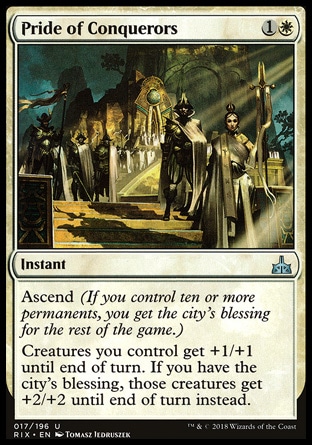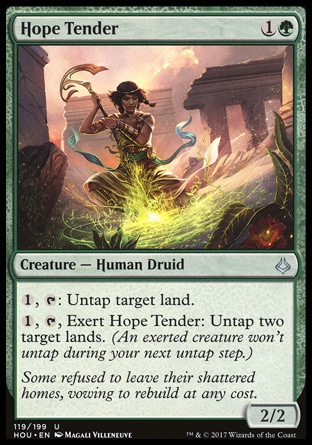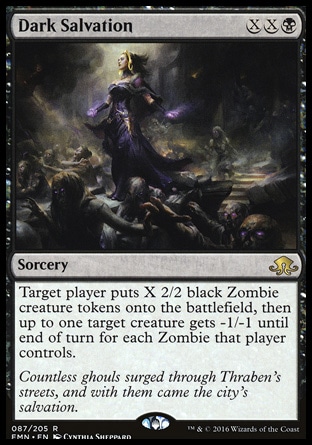Ahoy planeswalkers! Today, I’d like to take another look at Rivals of Ixalan now that the story is complete. My fellow hipster Levi Byrne, while preparing for his excellent piece on the issues with Ixalan’s choose-your-own-adventure conclusion, started a conversation in the Hipsters of the Coast chat that also brought up the interesting subject of the disconnect between the on-card storytelling of Rivals of Ixalan and the canonical Magic Story for the set. Indeed, the Magic Story team had to acknowledge this disconnect, working the cards Sphinx’s Decree and Golden Demise—cards that show major characters doing big things that did not end up happening in the story—into the epilogue as false memories implanted by Jace as part of a ruse to fool Nicol Bolas.
Even setting these cleverly-covered moments aside, there is a fair amount of dissonance between the flavor of the set (built around the four factions fighting within Orazca’s golden walls) and the actual Magic Story (in which the key characters raced to Orazca without backup). Huatli ended up being the only human fighting with vampires in Orazca; Luminous Bonds did not happen. Elenda emerged from her tomb on her own; a Profane Procession to the Tomb of the Dusk Rose was not needed to bring her back to the Dusk Legion. Vona, Mavren Fein, and Saint Elenda ended up being the only vampires to reach Orazca; Pride of Conquerors didn’t happen.

Now, I haven’t seen anyone grousing seriously about this disconnect, and my purpose in this article isn’t really to stake out a position within a community kerfuffle. Rather, this is my way of working through my own feelings about this, as someone who has at times been a bit fanatical about the relationship between Magic Story and the game’s on-card storytelling.
After all, this occasional disconnect isn’t really a new development. A scattering of cards that run counter to the canonical story has been fairly common in the Gatewatch era, especially in small sets. Consider Hope Tender from Hour of Devastation:

The flavor text suggests that some of Naktamun’s survivors remain in the city. In Magic Story, the only survivors we see flee with Hapatra or join Djeru and Samut in fighting to save Hazoret before leaving with their last goddess, leaving Naktamun to the Eternals. One could argue that this means that Hope Tender and those like her stay and die, but that’s really not the story that this card tells: it looks to occur after the cataclysm, at a time in which trying to rebuild is an actual possibility. (After all, how can you rebuild when you’re also worrying about a mob of blue metal zombies who want to stab you everywhere?)
Or look at Dark Salvation from Eldritch Moon:

The story this card tells is that Liliana saves Thraben with her horde of zombies. Again, if you squint right you can make somewhat of a case—her zombies keep the Gatewatch from getting overrun, buying Jace time to navigate his weird Fevered Visions with Emrakul until Emrakul possessed Tamiyo and seals herself in the moon. But taken at face value, Liliana’s undead horde does not singlehandedly turn the tide of the battle and save Thraben. (Indeed, the combined forces of Thalia and Olivia Voldaren do pretty well in their own right.)
As I thought about all this, though, I thought about a recent article by my fellow hipster Rob Bockman about Cherished Hatchling. Bockman offers a compelling reading of how Cherished Hatchling’s rules text and flavor sets up a compelling, potentially tragic story that can play out to a variety of conclusions over the course of a game of Magic.
Being as invested in Magic Story as I am, I think I tend to underrate this aspect of how the game’s storytelling works. The game of Magic was, after all, built on the flavor of a duel between planeswalkers, two powerful beings harnessing a plane’s innate magic in order to cast an array of spells with the aim of defeating a rival. Every game is the story of such a battle. From time to time I see other players bemoaning Magic’s movement away from this flavor, but the sense of a battles story persists, especially in factional limited environments that pit the Zendikari allies against the Eldrazi, the Consulate against the Renegades, the Dusk Legion against the River Heralds. When I sit down to play, I tend to feel more like a mage-general, able to lead my army of creatures and to help ensure their success through my noncreature spells. But that’s just me.
Point being, in a game of Magic, Liliana and her zombies can overrun Innistrad’s Eldrazi; the people of Naktamun can stave off the Eternals (and maybe even deliver a Puncturing Blow to Bolas’s twisted gods); vampires, dinosaurs, merfolk, and pirates can all claim the City’s Blessing en route to dispatching another tribe and claiming total victory. Why shouldn’t cards depict all these possibilities? Sure, they will not all be canon. But the Dusk Legion is certainly capable of the type of victory Pride of Conquerors celebrates; why shouldn’t that capacity be represented on a card?
There is also a lot to be said for the freedom offered by letting on-card storytelling and Magic Story stand on their own feet, rather than seeking total synergy. After all, Magic Story for the whole Ixalan block has been superb, in my opinion easily the best it’s been in the Gatewatch era (and I was already a fan). Alison Luhrs, Kelly Digges, and Greg Luben really knocked this one out of the park, and when I think about how much I’ve enjoyed reading the stories, I really don’t care that they have deviated this much from the set’s on-card storytelling. And there’s every reason to hope that the stories are going to get better still, with Wizards contracting the Dominaria story out to acclaimed fantasy and science fiction novelist Martha Wells. Why should I use mental energy fretting about any disconnects between card flavor and canonical story when the story is itself something this good that we get to enjoy for free?
The introduction of Story Spotlight watermarks could even help facilitate more non-canon on-card storytelling. It’s exciting to have the broad strokes of a set’s story sketched out over a few cards while leaving up in the air which other cards reflect a set’s true outcome, and it’s not like Wizards is going to do something so extreme as, say, dropping a fake major character death on a card.
In conclusion, I hope Wizards continues to let Magic Story and the set’s cards have some room to develop away from each other, such that some cards end up representing potential power that may not be actualized in the canonical story. The freedom to not have a huge, four-faction war in the middle of Orazca clearly benefited Magic Story, and I feel like glimpses of factions’ potential adds to the gameplay-flavor immersion of the sets, especially in limited.
Beck is a financial aid counselor and theatre history Ph.D. student who lives in the greater Boston area. He believes in playing standard like a Johnny, drafting like a Spike, and only playing modern decks that involve the number eight.

